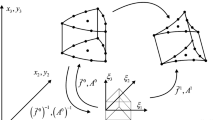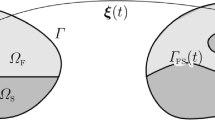Abstract
We present a geometric variational discretization of nonlinear elasticity in 2D and 3D in the Lagrangian description. A main step in our construction is the definition of discrete deformation gradients and discrete Cauchy–Green deformation tensors, which allows for the development of a general discrete geometric setting for frame indifferent isotropic hyperelastic models. The resulting discrete framework is in perfect adequacy with the multisymplectic discretization of fluids proposed earlier by the authors. Thanks to the unified discrete setting, a geometric variational discretization can be developed for the coupled dynamics of a fluid impacting and flowing on the surface of an hyperelastic body. The variational treatment allows for a natural inclusion of incompressibility and impenetrability constraints via appropriate penalty terms. We test the resulting integrators in 2D and 3D with the case of a barotropic fluid flowing on incompressible rubber-like nonlinear models.











Similar content being viewed by others
Notes
Given the polar decomposition \({\mathbf {F}} ={\mathbf {R}}{\mathbf {U}}\) of the gradient deformation, the principal stretches \(\lambda _1, \lambda _2, \lambda _3\) are the eigenvalues of \({\mathbf {U}}\). In particular \(\lambda _1^2, \lambda _2^2, \lambda _3^2\) are the eigenvalues of \({\mathbf {C}} ={\mathbf {U}}^2\).
For simplicity we didn’t write explicitly the dependence of the invariants on \( {\mathbf {G}} \) and assumed \({\mathbf {G}}_{ij}= \delta _{ij}\).
References
Angoshtari, A., Yavari, A.: A geometric structure-preserving discretization scheme for incompressible linearized elasticity. Comput. Methods Appl. Mech. Eng. 259, 130–153 (2013)
Ariza, M.P., Ortiz, M.: Discrete crystal elasticity and discrete dislocations in crystals. Arch. Ration. Mech. Anal. 178(2), 149–226 (2005)
Cirak, F., West, M.: Decomposition contact response (DCR) for explicit finite element dynamics. Int. J. Numer. Meth. Eng. 64, 1078–1110 (2005)
Cottet, G.-H., Maitre, E., Milcent, T.: Eulerian formulation and level set models for incompressible fluid-structure interaction. ESAIM-Math. Model. Numer. Anal. 42(3), 471–492 (2008)
Demoures, F., Gay-Balmaz, F., Ratiu, T.S.: Multisymplectic variational integrator and space/time symplecticity. Anal. Appl. 14(3), 341–391 (2014a)
Demoures, F., Gay-Balmaz, F., Ratiu, T.S.: Multisymplectic variational integrators for nonsmooth Lagrangian continuum mechanics. Forum Math. Sigma 4(e19), 54p (2016)
Demoures, F., Gay-Balmaz, F., Desbrun, M., Ratiu, T.S., Alejandro, A.: A multisymplectic integrator for elastodynamic frictionless impact problems. Comput. Methods Appl. Mech. Eng. 315, 1025–1052 (2017)
Demoures, F., Gay-Balmaz, F., Kobilarov, M., Ratiu, T.S.: Multisymplectic Lie group variational integrators for a geometrically exact beam in \({\mathbb{R} } ^3 \). Commun. Nonlinear Sci. Numer. Simulat. 19(10), 3492–3512 (2014b)
Demoures, F., Gay-Balmaz F.: Multisymplectic variational integrators for barotropic and incompressible fluid models with constraints, submitted (2021) arXiv:2102.10907
Gay-Balmaz, F., Marsden, J.E., Ratiu, T.S.: Reduced variational formulations in free boundary continuum mechanics. J. Nonlinear Sci. 22(4), 463–497 (2012)
Gotay, M. J., Isenberg, J., Marsden, J. E., Montgomery, R., Sniatycki, J., Yasskin, P. B.: Momentum maps and classical fields. Part I: Covariant field theory. (1997) arXiv: physics/9801019
Glowinski, R., Pan, T.-W., Périaux, J.A.: Lagrange multiplier/fictitious domain method for the numerical simulation of incompressible viscous flow around moving rigid bodies: (i) case where the rigid body motions are known a priori. CR Acad. Sci. Paris 25(5), 361–9 (1997)
Hirt, C.W., Amsden, A.A., Cook, J.L.: An arbitrary Lagrangian-Eulerian computing method for all flow speeds. J. Comput. Phys. 135(2), 203–216 (1997)
Hou, G., Wang, J., Layton, A.: Numerical methods for fluid-structure interaction - a review. Commun. Comput. Phys. 12(2), 337–377 (2012)
Kamrin, K., Rycroft, C.H., Nave, J.C.: Reference map technique for finite-strain elasticity and fluid-solid interaction. J. Mech. Phys. Solids 60(11), 1952–1969 (2012)
Kanso, E., Marsden, J.E., Rowley, C., Melli-Huber, J.-H.: Locomotion of Articulated Bodies in a Perfect Fluid. J. Nonlinear Sci. 15, 255–289 (2005)
Khayyer, A., Gotoh, H., Falahaty, H., Shimizu, Y.: An enhanced ISPH-SPH coupled method for simulation of incompressible fluid-elastic structure interactions. Comput. Phys. Commun. 232, 139–164 (2018)
Lefrançois, E., Boufflet, J.-P.: An introduction to fluid-structure interaction: Application to the piston problem. SIAM Rev. 52, 747–767 (2010)
Lew, A., Marsden, J.E., Ortiz, M., West, M.: Asynchronous variational integrators. Arch. Rational Mech. Anal. 167(2), 85–146 (2003)
van Loon, R., Anderson, P.D., van de Vosse, F.N., Sherwin, S.J.: Comparison of various fluid-structure interaction methods for deformable bodies. Comput. Struct. 85(11–14), 833–843 (2007)
Marsden, J.E., Hughes, T.J.R.: Mathematical Foundations of Elasticity. Prentice-Hall (1983)
Marsden, J.E., Patrick, G.W., Shkoller, S.: Multisymplectic geometry, variational integrators and nonlinear PDEs. Comm. Math. Phys. 199, 351–395 (1998)
Marsden, J.E., Pekarsky, S., Shkoller, S., West, M.: Variational methods, multisymplectic geometry and continuum mechanics. J. Geom. Phys. 38, 253–284 (2001)
Marsden, J.E., West, M.: Discrete mechanics and variational integrators. Acta Numer. 10, 357–514 (2001)
Mooney, M.: A theory of large elastic deformation. J. Appl. Phys. 11(6), 582–592 (1940)
Nocedal, J., Wright, S. J.: Numerical Optimization, Springer Series in Operations Research and Financial Engineering. Springer (2006)
Peskin, C.S., McQueen, D.M.: A three-dimensional computational method for blood flow in the heart i. immersed elastic fibers in a viscous incompressible fluid. J. Comp. Phys. 81, 372–405 (1989)
Peskin, C.S.: The immersed boundary method. Acta Numer. 11, 479–517 (2002)
Rivlin, R.S.: Large elastic deformations of isotropic materials. IV. Further developments of the general theory. Philos. Trans. R. Soc. A24I(6), 379–397 (1948)
Rivlin, R.S.: Large elastic deformations of isotropic materials. V. The problem of flexure. Proc. R. Soc. Lond. A195(6), 463–473 (1949)
Rivlin, R.S.: Large clastic deformations of isotropic materials. VI. Further results in the theory of torsion, shear and flexure. Philos. Trans. R. Soc. A242(6), 173–195 (1949)
Rockafellar, R.T.: Lagrange multipliers and optimality. SIAM Rev. 35(2), 183–238 (1993)
Rockafellar, R.T., Wets, R.J.-B.: Variational Analysis, Grundlehren der Mathematischen Wissenschaften, vol. 317. Springer-Verlag, Berlin (1998)
Simo, J.C., Laursen, T.A.: An augmented Lagrangian treatment of contact problems involving friction. Comput. Struct. 42(1), 97–116 (1992)
Yavari, A.: On geometric discretization of elasticity. J. Math. Phys. 49, 022901 (2008)
Author information
Authors and Affiliations
Corresponding author
Additional information
Communicated by Melvin Leok.
Publisher's Note
Springer Nature remains neutral with regard to jurisdictional claims in published maps and institutional affiliations.
A Appendix
A Appendix
1.1 2D Discrete Hyperelastic Models
To compute the partial derivatives \(D_k {\mathcal {L}} ^j_{a,b}\) of the discrete Lagrangian (34) we note

for all \(\ell =1,...,4\) and all \( k=1,3,5,7\). We observe that the 16 expressions  are independent of the value of the field \( \varphi _d \) and on the location of the spacetime node (if the spacing \( \Delta s_a\) and \( \Delta s_b\) are constant), i.e., we can write
are independent of the value of the field \( \varphi _d \) and on the location of the spacetime node (if the spacing \( \Delta s_a\) and \( \Delta s_b\) are constant), i.e., we can write  . For instance, for \(\ell =1\), we have
. For instance, for \(\ell =1\), we have
and for \(\ell =2\), we have
similarly for \(\ell =3,4\). We can thus write

where in the last equality we defined the operator \({\mathfrak {D}}_k^\ell \), \(k=1,3,5,7\), \(\ell =1,2,3,4\), by duality.
From this, the partial derivatives \(D_k {\mathcal {L}} _{a,b}^j\) of the discrete Lagrangian can be computed. For instance for \(k=1\) one has

Using this result, one then derives (42) from (75).
1.2 3D Discrete Jacobian

1.3 3D Discrete Cauchy–Green Deformation Tensor

1.4 3D Derivatives of Impenetrability Constraints (77)
Rights and permissions
Springer Nature or its licensor holds exclusive rights to this article under a publishing agreement with the author(s) or other rightsholder(s); author self-archiving of the accepted manuscript version of this article is solely governed by the terms of such publishing agreement and applicable law.
About this article
Cite this article
Demoures, F., Gay-Balmaz, F. Unified Discrete Multisymplectic Lagrangian Formulation for Hyperelastic Solids and Barotropic Fluids. J Nonlinear Sci 32, 94 (2022). https://doi.org/10.1007/s00332-022-09849-y
Received:
Accepted:
Published:
DOI: https://doi.org/10.1007/s00332-022-09849-y
Keywords
- Variational discretization
- Nonlinear elasticity
- Fluid-structure interaction
- Multisymplectic integrators
- Constraints
- Discrete Cauchy-Green tensors




